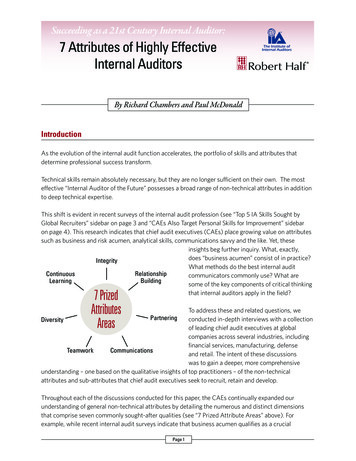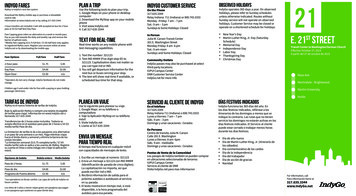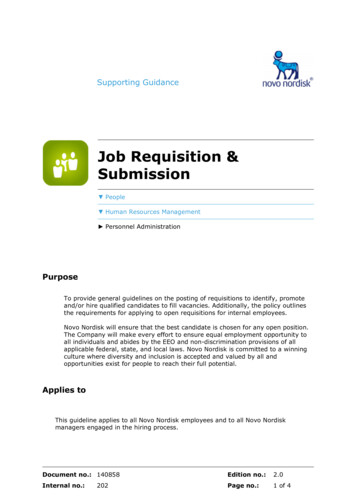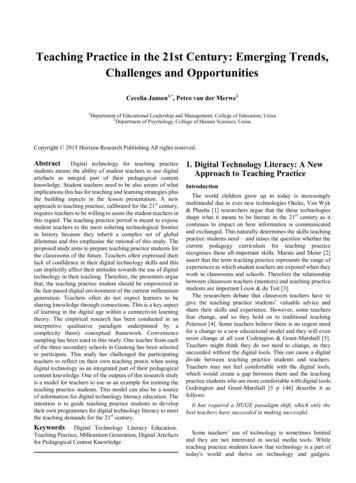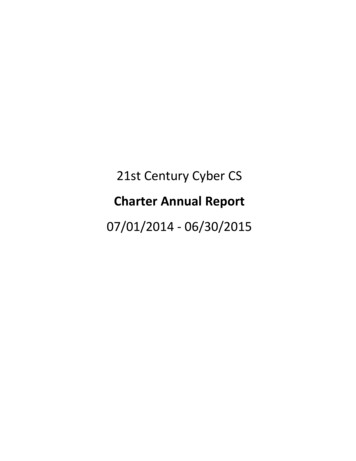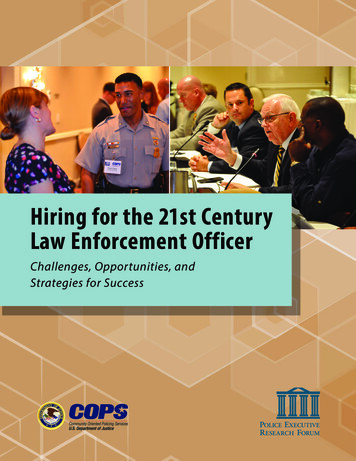
Transcription
Hiring for the 21st CenturyLaw Enforcement OfficerChallenges, Opportunities, andStrategies for Success
This project was supported by cooperative agreement number 2015-CK-WX-0018 awarded by the Office of Community Oriented PolicingServices, U.S. Department of Justice. The opinions contained herein are those of the author(s) and do not necessarily represent the officialposition or policies of the U.S. Department of Justice. References to specific agencies, companies, products, or services should not beconsidered an endorsement by the author(s) or the U.S. Department of Justice. Rather, the references are illustrations to supplementdiscussion of the issues.The Internet references cited in this publication were valid as of the date of publication. Given that URLs and websites are in constant flux,neither the author(s) nor the COPS Office can vouch for their current validity.Recommended citation:Morison, Kevin P. 2017. Hiring for the 21st Century Law Enforcement Officer: Challenges, Opportunities, and Strategies for Success. Washington,DC: Office of Community Oriented Policing Services.Published 2017
ContentsLetter from the Director of the COPS Office . iiiLetter from the Executive Director of PERF . vAcknowledgments. viiIntroduction: Shaping the Policing Profession for the 21st Century . 1Diverse personnel, diverse perspectives . 2Three overarching themes . 3Discussion, recommendations, and promising practices . 4Nexus of recruitment and hiring . 41. Hiring Candidates Who Share the Values and Vision of the Community and the Department . 5Identify key traits and characteristics . 6Operationalizing the process . 7A new look at traditional measures . 9Still need to “screen out the negative”. 13Dealing with past drug use . 13Dealing with bias—explicit and implicit . 16Providing context for financial responsibility issues. 18A new look at some traditional tools . 18Reviewing candidates from other agencies . 21Ensuring the process is fair . 23Recommendations and promising practices:Hiring candidates who share the values and vision of the community and the department . 262. Making the Hiring Process More Efficient . 29Different processes, different timelines . 30Procedural inefficiencies. 31Promising approaches to accelerate the hiring process . 33Recommendations and promising practices: Making the hiring process more efficient . 36i
3. Advancing Diversity and Inclusiveness in the Hiring Process. 41“Grow your own” . 41Watch out for guardians of the existing culture . 45The fallout from “zero tolerance” policing . 47Recommendations and promising practices: Advancing diversity and inclusiveness in hiring . 494. Other Issues to Consider . 51Changing standards on tattoos . 51Raising the minimum age for police officers . 54Recruiting and hiring qualified civilian professionals . 55Recommendations and promising practices: other issues to consider . 58Conclusion: Promising Practices for Moving the Profession Forward . 59List of Forum Participants . 62Law enforcement, academic, and organizational participants. 62Federal participants . 65About PERF . 66About the COPS Office . 67iiHiring for the 21st Century Law Enforcement Officer
Letter from the Director of theCOPS OfficeDear Colleagues,In July 2016, President Obama convened law enforcement and civil rights leaders, as well as members ofthe President’s Task Force on 21st Century Policing, for a candid, solutions-oriented dialogue aboutimproving police-community relations. There was consensus among participants that further discussionswere needed to focus on recruiting for a diverse workplace, and on the challenges, often during thehiring process, that agencies experience in making that a reality.In response to this meeting, President Obama asked the COPS Office to explore these topics and provideadditional recommendations for law enforcement agencies as they work to improve the recruitmentand hiring process. Together with the Police Executive Research Foundation (PERF), the COPS Officehosted the Hiring for the 21st Century Law Enforcement Officer forum in September 2016. Thispublication is a companion to the Law Enforcement Recruitment in the 21st Century forum convened inpartnership with Strategic Applications International.The hiring forum brought law enforcement executives, human resources professionals, and otherstakeholders together to explore hiring rules and procedures that both support and challenge hiringthose candidates who are psychologically suited, qualified, and have the temperament to be policeofficers. But beyond rules and procedures, it is critically important to look at the hiring process to ensurethat those candidates who are hired meet the high standards of the profession.The forum participants’ forthright discussions and varied insights and experiences can be of great valueto Peace Officer Standards and Training (POST) commissions, agency HR personnel, state civil serviceboards, and others concerned with officer hiring and retention. I commend PERF for the importantcontribution they have made to American law enforcement by convening this forum and preparing thisreport.iii
The benefits of hiring individuals who not only reflect the communities they serve but also embodyAmerican law enforcement values of justice and service will benefit us all long into the future. Thisreport is an excellent place to start.Sincerely,Ronald L. DavisDirectorOffice of Community Oriented Policing ServiceivHiring for the 21st Century Law Enforcement Officer
Letter from the Executive Directorof PERFThe American policing profession may be facing the most fundamental questioning of its legitimacy indecades. The very essence of policing is being debated in many cities, often because of controversialvideo recordings of police officers’ actions. Community trust has eroded, and the professionalism of thepolice is being questioned. At the same time, far too many officers are being killed in the line of duty, inmany cases in cowardly ambush attacks. All of this has made community members and police officersconcerned about their safety and has prompted leading police officials to go back to the beginning andtake a fresh look at the police officers they are hiring. Do the officers represent the values of ourcommunities? Do they share the philosophy of policing that we are developing for the 21st century? Dothey have the skills and talents they will need to do the job we want them to do?Policing used to be a profession shared within families from generation to generation. We all knowfamilies that count many officers among their sons and brothers and uncles, and sometimes theirdaughters, sisters, and aunts as well. But, sadly, these days when PERF gathers a large group of seniorlevel police executives together for a meeting and I ask them, “How many of you would like to see yourchildren become tomorrow ’s police officers?” very few, if any, raise their hands.The country is facing a looming crisis in the hiring of police officers. Agencies continue to rely on hiringstandards that were created decades ago, for a different philosophy of policing and a differentgeneration of police officer candidates—even while many cities are having trouble finding enoughsuitable candidates to keep up with retirements and fill vacant positions. Today’s young peopleconsidering a job in policing expect agencies to be quicker, more nimble and transparent in their hiringprocesses and decision making—and for many young people, especially in minority communities,policing is not seen as an appealing career choice in the current climate.However, there are signs of hope, innovation, and change. At the September 13, 2016, forum “Hiring forthe 21stst Century Law Enforcement Officer,” police agency leaders, labor representatives, professionalassociation executives, academicians, civil service managers, and others directly involved inv
police hiring discussed the issues facing the profession and explored new ideas and approaches. Theirexperiences and insights, presented in this report, provide a valuable resource that should help agenciesof all sizes better understand the common challenges they face.Sincerely,Chuck WexlerExecutive DirectorPolice Executive Research ForumviHiring for the 21st Century Law Enforcement Officer
AcknowledgmentsThe Police Executive Research Forum (PERF) would like to thank the U.S. Department of Justice’s Officeof Community Oriented Policing Services (COPS Office) for supporting this examination of changes andinnovations in police hiring practices to support the 21st century policing philosophy. We support COPSOffice Director Ronald L. Davis’s commitment to exploring new ideas and approaches to ensure policeagencies’ hiring practices are attracting the right candidates. Thanks go to COPS Office staff, particularlyHelene Bushwick and Brenda Auterman, for their support and encouragement throughout the project.We would also like to thank the more than 50 police agency leaders, labor representatives, professionalassociation executives, academicians, civil service managers, and others directly involved in police hiringwho attended our September 13, 2016, forum in Washington, D.C. (see the list of participants on page62). Their participation provided us with insight on how agencies have revamped and streamlined theirhiring processes and policies in order to attract and hire the best candidates.Finally, credit is due to PERF staff members who prepared for and hosted the joint COPS Office and PERFforum and who wrote and edited this publication: Jessica Toliver, director of Technical Assistance; KevinMorison, director of Program Development; Craig Fischer, director of Communications; Elizabeth Miller,research associate; and Adam Kemerer, research assistant.vii
Introduction: Shaping the PolicingProfession for the 21st Century“To build a police force capable of dealing w ith the complexity of the21st century, it is imperative that agencies place value on botheducational achievements and socialization skills when making hiringdecisio ns. Hiring officers who reflect the co mmunity they serve isimportant not only to external relations, but also to increasingunderstanding within the agency.”– President’s T ask For ce on 21st Cent ury PolicingThe President’s Task Force on 21st Century Policing (task force) recognized that a police agency’sprocess for hiring new officers can be the foundation of effective, procedurally just policing. In its finalreport, the task force highlighted the importance of hiring officers who reflect the diversity and values ofthe community, and who have both the mindset and the skills needed to engage with the community.The task force encouraged states to establish high standards for who qualifies to be a police officer, andit recommended that agencies ensure that the officers they hire possess “the character traits and socialskills that enable effective policing and positive community relationships.” 1The task force emphasized why the issue of hiring is so important to policing in the 21st century, but itdid not go into great detail about how agencies can improve their hiring standards and procedures. Thattype of specific guidance was beyond the scope of the task force. However, as a follow-up to the taskforce’s report, the U.S. Department of Justice’s Office of Community Oriented Policing Services (COPSOffice) and the Police Executive Research Forum (PERF) organized a day-long forum titled “Hiring for the21st Century Law Enforcement Officer.” Held on September 13, 2016, in Washington, D.C., the meetingbrought together approximately 50 expert practitioners, primarily in the fields of police standards,screening, and hiring. The meeting was moderated by Chuck Wexler, executive director of PERF.1President’s Task Force on 21st Century Policing, Final Report of the President’s Task Force on 21st Century Policing(Washington, DC: Office of Community Oriented Policing Services, 2015), 51,https://cops.usdoj.gov/pdf/taskforce/taskforce finalreport.pdf.1
Diverse personnel, diverse perspectivesThe majority of forum participants were sworn and civilian personnel from a range of police agencies ofdifferent sizes and from different regions of the country. They included lieutenants, captains, commandpersonnel, and chief executives. These practitioners were selected because their agencies hadimplemented innovative hiring programs that have shown promise in their communities and that maybe useful models for other jurisdictions.The forum also included representatives from the following entities and disciplines: Labor organizations in policing State agencies responsible for police standards Professional associations representing police chiefs, sheriffs, women in law enforcement, Hispaniccommand officers, mayors, the transgender community, and police trainers Municipal civil service agencies Practitioners in the field of police psychology Academic expertsThey were joined by PERF staff members and representatives of the COPS Office and other federalagencies (see the complete list of forum participants on page 62). Their charge was to explore howpolice agencies can make effective hiring decisions that serve their individual organizations and advancethe policing profession as a whole.“Whether it’s building trust and legitimacy, fighting crime and violence,implementing new technologies such as body cameras, or addressing thechallenges of police use of force—there isn’t a challenge that we’refacing right now that doesn’t point back to the issues of recruitmentand hiring.”– Ronald L . Davis, Director, COPS Office2Hiring for the 21st Century Law Enforcement Officer
Three overarching themesThe forum covered a wide variety of issues. These ranged from detailed aspects of the hiring process(such as agency policies on candidates’ past drug use) to “big picture” issues, such as hiring philosophies,advancing diversity, and addressing implicit bias among officer candidates. The session also includeddiscussions of the practical aspects of streamlining the hiring process and of organizing and operatingpolice cadet and internships programs to introduce high-quality candidates into the hiring processThis report summarizes the major issues explored in the forum. These issues are organized around threethemes: Hiring candidates who share the values and vision of the community and the department. Thissection explores how some agencies are using the hiring process to do more than disqualifyindividuals who fail to meet basic standards. Rather, more and more agencies are using the processto “hire the positive”—that is, to attract and ultimately hire people who reflect the values and visionof the law enforcement agency and the community. This section also explores new ways of thinkingabout such traditional disqualifiers as past drug use (an increasingly complex matter, given the trendtoward marijuana legalization or decriminalization in many states) and applicants’ financialdifficulties (which may be a result of poor economic conditions nationwide). This section alsoexamines the role of polygraph exams, psychological screenings, and the National DecertificationIndex, a relatively new and underused tool to help agencies screen candidates in a morecomprehensive, multijurisdictional fashion. Making the hiring process more efficient.Traditionally, the police hiring process in most agencies has been slow and cumbersome. As a result,some agencies are losing qualified candidates to other departments, and in some cases, the policingprofession is losing highly attractive candidates to other professions. This section of the reportexplores what some agencies are doing to shorten the hiring process and make it more efficient anduser-friendly to applicants. Forum participants emphasized that speed and efficiency in hiring areespecially important among the younger generations—Millennials and Generation Z 2—who makeup the bulk of people now entering the workforce. Advancing diversity and inclusiveness in the hiring process.This section examines how agencies are meeting their goals of building a workforce that reflects thediversity of the communities they serve, while also ensuring high-quality candidates and a processthat is fair to everyone. Hiring Forum participants described new approaches to “growing their owncandidates” through programs such as police explorers, cadets and internships. They also discussedthe important role that background investigators play not just in screening and evaluatingcandidates, but also in shaping the “culture” of an agency.2Definitions vary, but Millennials are generally thought to include persons born in the 1980s to mid-1990s, whileGeneration Z, also known as Post-Millennials, the iGeneration, or the Homeland Generation, includes persons bornbeginning in the mid-1990s to early 2000s.Introduction: Shaping the Policing Profession for the 21st Century3
In addition, this report examines a number of other issues confronting today’s police hiring authorities.These include, for example, whether visible tattoos undermine the image of police officers that anagency may wish to convey, whether to raise the minimum age for new hires, and how the hiring ofcivilian employees can support agency goals while relieving some pressure on the process of hiringsworn officers. The report also discusses new thinking about educational requirements and physicalstandards in the hiring process.Discussion, recommendations, and promising practicesIn each chapter, the report presents an overview of the key issues discussed in the forum. In addition,the report presents a number of specific recommendations and promising practices for agencies toreview. In this respect, the report builds on the foundation established by the Final Report of thePresident’s Task Force on 21st Century Policing by presenting practical and useful information and actionitems for agencies to consider and implement.Nexus of recruitment and hiringThis forum followed a separate session on police recruitment, also sponsored by the COPS Office. Likethe hiring forum, the meeting on police recruiting brought together experts from multiple disciplinesand multiple agencies. The recruitment forum explored innovative ways to attract diverse, qualified, andcommunity-oriented people to the policing profession in the first place—in other words, to get them inthe door. As a complement to that meeting, the hiring forum centered on how to efficiently screen andevaluate those candidates who have expressed an interest in policing, and how to get the bestcandidates through the hiring process and out into the community as 21st century police officers.Together, recruitment and hiring play a major role in shaping how police agencies develop, grow, andultimately succeed. As COPS Office Director Ronald Davis noted at the hiring forum, there are few majorissues confronting policing today that do not stem from recruitment and hiring on some level. The twoCOPS Office–sponsored forums provide guidance on how agencies can move forward in a unifiedmanner on both fronts.4Hiring for the 21st Century Law Enforcement Officer
1. Hiring Candidates Who Share theValues and Vision of the Community andthe Department“About three or four years ago, we started to look at our hiring processin terms of our outco mes. We’re trying to find the right indiv iduals whowe can train to be the kind of officers we w ant. We can give themtraining, but if they are not coming in with those human qualities thatyou want, we can’t train those . So we say ‘Hire the heart, train thebrain.’”– Karianne T homas , Deputy Chief,Kalam azoo (Michigan) Department of Public SafetyTraditionally, police agencies have used the hiring process primarily as a way to identify and excludecandidates who do not meet certain agency standards. Applicants who pass a basic written examinationand other minimum entry requirements are put into a background investigation process that focusesalmost exclusively on trying to uncover issues in the candidates’ backgrounds that would disqualify themfrom service. For some candidates, it feels as if they are being treated more like criminal suspects thanjob applicants.Participants at the hiring forum did not discount the importance of weeding out candidates who lack theethical foundation, moral compass, and basic capabilities to be a police officer. In fact, much of thediscussion focused on how to improve systems and procedures to be more accurate, discerning, andefficient in identifying unsuitable candidates.However, many forum participants emphasized that in the 21st century, police agencies need to use thehiring process to do more than simply disqualify the negative. Agencies need to use that process toproactively identify and hire the positive—the candidates who possess the values, character traits, andcapabilities that agencies are looking for in their employees. For many forum participants, that change inperspective about the basic purpose and ultimate value of the hiring process was seen as a critical firststep toward improving the system and getting better outcomes.5
Identify key traits and characteristicsWhat are those positive traits, characteristics, and skill sets that agencies need to hire for in the 21stcentury? And how can agencies measure and evaluate those qualities? While the answers to thosequestions will vary somewhat from agency to agency, forum participants offered some helpfulsuggestions.The first step is for agencies to clearly identify what specific traits and characteristics they are seeking intheir officers. These are the qualities that go above and beyond the minimum standards that areestablished by many state Police Officer Standards and Training (POST) agencies. Each agency’s list willbe guided in large part by the policing philosophy of that agency. Still, forum participants identified anumber of fundamental qualities that all agencies should embrace, which include the following: Integrity Service orientation Empathy Communication and human relations skills Self-control Team orientation Problem-solving skillsSeveral forum participants noted that while the traditional approach to police hiring has skewed heavilytoward the “warrior” aspects of the profession, agencies today need to focus attention on recruiting andhiring for the “guardian” role that police officers must be prepared to play. In fact, some forumparticipants argued that agencies should concentrate most of their attention on ensuring that applicantscoming into the system have the necessary qualities of the guardian, because the warrior elements ofthe job can be taught.“You have to understand what your community expects of your policeofficers, and implement those expectations. If you do n’t have arelationship with the community and your o fficers aren’t exemplifyingthe behavior the community wants, you’re not going to be able torecruit the people you want to hire.”–Commander David Robins on, Dearbor n (Michigan) P olice Department6Hiring for the 21st Century Law Enforcement Officer
Identifying the key traits that applicants should possess must be more than an internal brainstormingsession. Agencies should also solicit the input of community members. What are their expectations?What qualities and skills do residents, business owners, civic leaders, and others want to see in theofficers who police their communities? After all, these are the people who are the primary recipients ofpolice services, and they have a vested interest and a unique perspective on what constitutes effectivepolicing. If agencies are not asking for the community’s input on the hiring process, they are not gettinga complete and accurate picture of the workforce they should be looking to build.“When we looked at o ur process, we started by trying to identify whattype of officer we would like to see in the co ming generation. We’retrying to focus more on officers with pro blem-solving skills,communication skills, and interperso nal skills. There’s a lot in policingthat we can teach to an officer, but we don’t believe that we can teachthe fundamental hum an ability to interact well with others.”– Brian M axey, Chief Operating Officer,Seattle (Washington) Police DepartmentOperationalizing the processOnce agencies have identified the core set of traits, characteristics, and capabilities they are looking forin officer candidates, they need to operationalize the process of hiring people who match those ideals.Clearly, that process starts well before an applicant ever takes a written test or enters the backgroundprocess. It begins with how and where agencies recruit potential candidates in the first place. As Dr.Patrick Oliver, Director of Criminal Justice Programs at Cedarville University, stated, “Once you knowwhat you’re looking for, where do you go and find that kind of a person?” For example, in the search forcandidates who possess the full range of traits needed by today’s police officers, recruiting and hiring gohand-in-hand. Agencies can’t screen for and ultimately hire their strongest and most well-roundedcandidates if their recruiters have not identified those people and encouraged them to start the process.This is called “Targeted Selection,” and it is considered an especially effective recruitment method.Within the hiring and screening process itself, evaluating and measuring the desired qualities and traitsof officer candidates are not simple tasks. They require effort, resources, and some creativity on the partof hiring agencies. Major James Handley of the Baltimore Police Department noted that civil servicetests are currently based mostly on cognitive abilities. Baltimore police are working with the city’shuman resources department to update the test so that it measures key personality traits as well.1. Hiring Candidates Who Share the Values and Vision of the Community and the Department7
“Once you’ve met statutory criteria and you’re selecting candidates, Ireally like scenario-based questioning in the interview process. I thinkthat’s a good way to identify the candidates with the characteristics youwant.”– Sean Smoot, Director,Police Benevolent & Protective Ass ociation of IllinoisOther jurisdictions are expanding their oral interview process to focus more on community-orientedskills and capabilities. For example, the Dallas (Texas) Police Department conducts in-depth interviewswith candidates that include question
Dec 01, 2014 · to Peace Officer Standards and Training (POST) commissions, agency HR personnel, state civil service boards, and others concerned with officer hiring and retention. I commend PERF for the important contribution they have made to American law enfor

